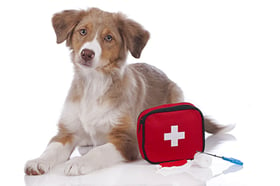What would you do if your pet had a medical emergency? Do you know what to do if your cat cuts his leg on something in the yard? What if your dog gets overheated playing in the park? April is Pet First Aid Awareness Month so as part of our ongoing quest to help you be a superstar pet parent, here are some tips to help you be prepared in the event of an emergency.

Cuts and scrapes
If your pet gets a cut (also called a laceration) and they are bleeding, use a clean cloth or paper towels to put pressure on the wound. This will help slow down the bleeding and give them time to form a blood clot. Once the bleeding has stopped or slowed down, you can examine the wound more closely. If the cut is severe or does not stop bleeding, continue to place pressure on the wound and get to your nearest veterinary hospital. There, they can perform a more thorough evaluation and determine if stitches are needed.
Overheating
If your pet has been playing outdoors or has been in an area that is very warm, you may notice that they are breathing heavier and seem very tired or weak. If you have a thermometer, try and take their rectal temperature (be sure to lubricate the thermometer with some petroleum jelly or baby oil first). A normal temperature for a dog or cat is < 102.5. If they are above this, get them into a cool environment right away and place some damp towels on them to try and get their temperature down. Dogs or cats with a temperature > 104 or who experience bloody diarrhea, weakness, or collapse, need to see a veterinarian right away as they may be experiencing a heatstroke which can be life –threatening.
Seizures
A pet who is having a seizure will often fall over and become rigid or start paddling its legs. They may vocalize or lose control of their bowels. If your pet is having a seizure, do not put your hands near their face (they may accidentally bite you) but do try to make sure they are in a safe place where they won’t fall or hurt themselves. Try to make a note of how long the seizure lasts. Once the seizure passes, your pet may act very disoriented or aggressive. Keep them calm and quiet and be sure to call your veterinarian as they may need to be seen to determine the cause of the seizure. If the seizures are severe or continuous, get them to a veterinarian right away. Continued seizure activity can hurt their brain and needs to be addressed right away.
Intoxications
If you know that your pet has eaten something that it should not have eaten (e.g., a medication, a cleaning product, plant, trash, etc.), call your veterinarian or nearest emergency clinic right away for advice. If possible, have the packaging of what they got into available. There are some toxins where it is a recommended to make your pet vomit but this is NOT the case for all toxins. If your pet is acting ill (dilated pupils, strange behavior, vomiting, diarrhea, seizures, or loss of consciousness), take them to your veterinarian right away. They can help determine what is going on and if there is a specific therapy that they need.
Remember, first aid is not meant to substitute veterinary care, so always call or go see your family veterinarian or nearest emergency clinic if your pet experiences a medical emergency. We are here to help!
The American Red Cross also has a list of items to keep on hand at home for pet emergencies as well as a handy Pet First Aid App!
This blog post is brought to you by the SLVS team. If you have a suggestion for a future post, please leave it in the comments section below…




